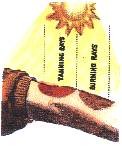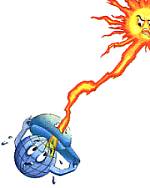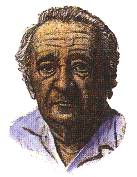| F
U N I N T H E S U N |
|
|
|
Introduction |
|
|
Every
year, we can be exposed to thousands of hours of sunlight.
Being in the sun makes us feel warm and healthy. But too much
exposure to sunlight can cause discomfort and skin problems.
For over fifty years, the COPPERTONE name has been associated
with sun protection, beaches, sports and family fun. By being
aware on the cumulative effects of sun exposure
and by following the simple guidelines outlined in this brochure
you can continue to enjoy a lifetime of safe, responsible
fun in the sun!
|
|
What
is Sunlight?
 Sunlight
is made up of invisible ultraviolet rays which are responsible
for the tanning and burning effects on skin. According to
the American Skin Cancer Foundation, sunlight is responsible
for over 90% of all skin cancers. Sunlight
is made up of invisible ultraviolet rays which are responsible
for the tanning and burning effects on skin. According to
the American Skin Cancer Foundation, sunlight is responsible
for over 90% of all skin cancers.
What is Ultraviolet Radiation (UV)?
The sun is the energy source that sustains
all life on earth. Ultraviolet Radiation (UV) is simply one
form of energy coming from the sun. Eventhough you may have
only just started hearing about UV and the effects is has
on you, it is nothing new - in fact, UV is as old as the Earth
itself. However, research over the years has helped us to
understand better how this form of energy from the sun affects
us.
Some
of these ultraviolet rays stimulate a chemical in the skin
called melanin to rise to the surface. Melanin is a darkening
pigment and the closer it is to the surface of the skin, the
more tanned you look.
UV rays are the sun's invisible "burning"
rays - the ones that cause redding of the skin, sunburn and
overexposure has been directly linked to premature wrinkling
and skin cancer. There are three (3) types of ultraviolet
rays:
UV-A.
These
rays of the sun maintain a relatively constant intensity
throughout the year and also penetrate more deeply into
the skin layers than UV-B rays. These rays contribute to
premature aging and wrinkling of the skin, sunburn and even
to skin cancer.
UV-B.
These rays, which are stronger
than UV-A, are more intense in summer months, at higher
attitudes and closer to the equator. UV-B is the most common
cause of sun burning, can contribute to the premature aging
of the skin and can cause cataract - a permanent clouding
of the eye which greatly reduces vision. The UV-B exposure
we get over the course of our life can even cause skin cancer
and alter your immune system.
UV-C.
These rays, although the
strongest and most dangerous, are normally filtered by the
ozone layer and do not reach the Earth.
What
is an Ozone Layer?
The earth's ozone layer is a protective
shield of atmospheric gas that filters out certain wavelengths
and affects the amount of ultraviolet radiation passing through
the atmosphere. It prevents dangerous UV rays from reaching
the earth.
Man-made chemicals believed to destroy
ozone is called chloroflourocarbons, which are used in aerosols
and refrigeration. Reduction in the ozone layer may lead to
greater exposure to UV radiation. According to the U.S. Environmental
Protection Agency, a 5% decrease in the ozone layer could
increase ultraviolet radiation by about 10%, which in turn,
could increase the incidence of skin cancer by as much as
20 percent within the next two (2) decades.
|
Sunburn |
|
What
is Sunburn?
 Sunburn
is skin damage caused by overexposure to the sun. It is extremely
common, but it is important to be able to recognize it and treat
it properly. There are two (2) basic types of sunburn: Sunburn
is skin damage caused by overexposure to the sun. It is extremely
common, but it is important to be able to recognize it and treat
it properly. There are two (2) basic types of sunburn:
- First
Degree-Burn. Normally experienced as redness of the skin.
Discomfort can usually be relieved with over-the-counter
products such as lotions and analgesics.
- Second
Degree-Burn. Normally experienced as skin blisters and swelling.
A person with this type of burn needs to seek the advice
of doctor.
Symptoms
of Sunburn
Just
a few hours after being in the sun, the following may occur:
- redness
of skin
- blistering,
facial swelling
- loss
of fluids (dehydration)
- general
feeling of weakness and fatigue
- pain
- nausea
and chills
If
any of these conditions is sever, a doctor should be consulted.
Long-term
effects of too much Sun
After years of exposure to the sun,
the cumulative effects can be seen as the ff:

- changes
in skin color, brown spots
- loss
of skin elasticity, sagging
- premature
wrinkling, leathery skin
- skin
cancers
Protecting
your skin to avoid short-term effects of the sun will also
help your skin in the long run.
|
|
 |
OFFICE
HOURS |
| |
08:30AM
- 05:30PM
(GMT+8 or PST+16)
Monday - Friday excluding Philippine Holidays
08:00AM - 05:00PM
(GMT+8 or PST+16)
Saturday excluding Philippine Holidays
US
Toll Free Number:
+1-(877)-839-4128
Philippine
Number:
+63-2-8978709
+63-2-3383279
UK
Phone Number:
+44-20-7096-1370
|
| |
|
 |
CORPORATE
TRAVEL
|
| |
Need
a place for company outings, group travel or for a big family
vacation? Worry no more for we have the right promos for you!
Book
with us and get complimentary
premium accounts in JobsCity.NET for each reservation! |
| |
|
 |
HOTEL
OWNERS!
|
| |
Participate
in our Instant
Confirmation feature and see your sales shoot up! |
| |
|
 |
AMANPULO
PALAWAN
|
| |
Discovery
one of palawan's finest getaway place,
Amanpulo!
|
|
|
 |
AFFILIATE
PROGRAM
|
| |
10%
commission on hotel bookings! JOIN
NOW!
Affiliate members, check
and manage your affiate account easier! |
| |
|
| |
|
|


